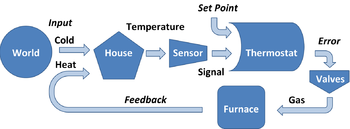Feedback: Difference between revisions
imported>Nick Gardner (New page: {{subpages}} <!-- Text is transcluded from the Feedback/Definition subpage-->) |
imported>John R. Brews (Start page) |
||
| Line 1: | Line 1: | ||
{{subpages}} | {{subpages}} | ||
< | {{TOC|right}} | ||
'''Feedback''' is an alteration of the input to a system based upon a monitored internal state that changes the input either to change a monitored internal state (positive feedback), or to maintain it (negative or degenerative feedback). | |||
==Example== | |||
{{Image|Thermostat system.png|right|350px|Thermostatic control of house temperature using a negative feedback system.}} | |||
The thermostatic control of house temperature is a commonly used example of a negative feedback system.<ref name= Ganesh/> In the figure, the house temperature is a response to the combined heat input from the world and from the furnace. Suppose a change occurs in the heat supplied to the house by the outside world. The resultant house temperature is sensed by a thermometer and converted to an electrical signal. This signal is compared by the thermostat to a set-point signal that corresponds to the desired temperature value. The discrepancy between the set point and the signal is calculated as an error signal by the thermostat, triggering action by the furnace. Depending upon the sign of the error the furnace produces more or less heat, regulating the combined heat input to the house so the temperature stays constant. In other words, the information on system temperature is used to generate ''feedback'' that keeps the temperature at value. | |||
The same principle is found in biology as [[Homeostasis (biology)#.C2.A0.C2.A0.E2.80.A2_Negative_feedback|homeostasis]].<ref name=Sherwood/> | |||
==References== | |||
{{reflist |refs= | |||
<ref name= Ganesh> | |||
{{cite book |title=Control engineering |author=Rao Ganesh |chapter=Feedback control |pages=pp. 29 ''ff'' |url=http://books.google.com/books?id=L0ne8OjCd1IC&pg=PA29 |isbn=9788131732335 |publisher=Pearson Education India |year=2010}} | |||
</ref> | |||
<ref name=Sherwood> | |||
See, for example, {{cite book |title=Fundamentals of Physiology: A Human Perspective |author=Lauralee Sherwood |url=http://books.google.com/books?id=wKeMwozogmoC&pg=PA14 |pages=p. 14 |isbn=9780534466978 |publisher=Cengage Learning |year=2005 |edition=3rd ed }} | |||
</ref> | |||
}} | |||
Revision as of 12:21, 4 June 2014
Feedback is an alteration of the input to a system based upon a monitored internal state that changes the input either to change a monitored internal state (positive feedback), or to maintain it (negative or degenerative feedback).
Example
The thermostatic control of house temperature is a commonly used example of a negative feedback system.[1] In the figure, the house temperature is a response to the combined heat input from the world and from the furnace. Suppose a change occurs in the heat supplied to the house by the outside world. The resultant house temperature is sensed by a thermometer and converted to an electrical signal. This signal is compared by the thermostat to a set-point signal that corresponds to the desired temperature value. The discrepancy between the set point and the signal is calculated as an error signal by the thermostat, triggering action by the furnace. Depending upon the sign of the error the furnace produces more or less heat, regulating the combined heat input to the house so the temperature stays constant. In other words, the information on system temperature is used to generate feedback that keeps the temperature at value.
The same principle is found in biology as homeostasis.[2]
References
- ↑ Rao Ganesh (2010). “Feedback control”, Control engineering. Pearson Education India, pp. 29 ff. ISBN 9788131732335.
- ↑ See, for example, Lauralee Sherwood (2005). Fundamentals of Physiology: A Human Perspective, 3rd ed. Cengage Learning, p. 14. ISBN 9780534466978.
